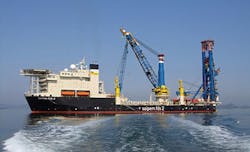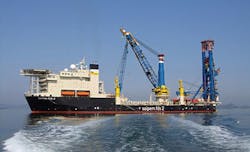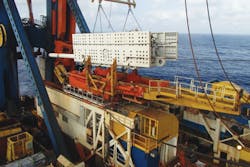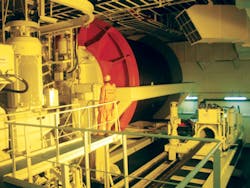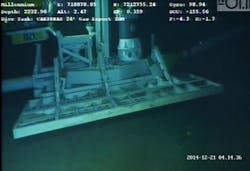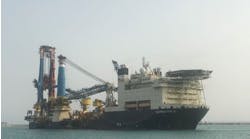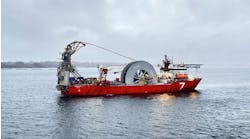Saipem FDS2 achieves two new world records offshore Brazil
P.E. d’Huart, C. Chiodini
Saipem
Saipem’s field development and pipelay vesselFDS2 has set two world records while undertaking work on Petrobras’ Cabiúnas project offshore Brazil. The project involved installation of a 380-km (236-mi), 24-in. gas export pipeline in water depths down to 2,250 m (7,381 ft).
In the space of just a few months, theSaipem FDS2 set two records in a row: the vertical pipe laying tension world record; and the installation of the largest, deepest, and heaviest free standing hybrid riser.
Saipem FDS2 set two world records on Petrobras’ Cabiúnas project. (All images courtesy Saipem)">
The first of the two records – on which this article will focus – was set in December 2014 on the Rota Cabiúnas contract, awarded by Petrobras to Saipem. For this project, theFDS2 laid the deepest section of a 24-in. pipeline in the Santos basin, which had a wall thickness ranging from 1.25-in. to 1.438-in. at water depths from 1,700 m to 2,240 m (5,577 ft to 7,349 ft).
A specific ultra-high-tension j-lay configuration was planned, engineered, and implemented for the purpose of maximizing vessel operability in harsh environmental conditions. This plan was made possible by theFDS2’s tension capabilities, which allowed the planning of laying operations even in flooded configuration. The maximum tension recorded on the project of 760 metric tons (mT) (837 tons) – which to date represents a vertical pipe laying tension world record – was nonetheless well within the FDS2’s maximum laying capacity of 1,500 mT (1,653 t) and contingency holding capacity of 2,000 mT (2,204 t), both in friction. The vessel’s j-lay tower was also used to lay five in-line-items and the pipe end assembly safely and efficiently.
Cabiúnas project
Rota Cabiúnas is a 24-in. rigid gas export line that connects the Cernambi field to the Cabiúnas terminal in Macaé, in the state of Rio de Janeiro. It is the second route developed by Petrobras for the flow of gas produced in the Santos basin.
The shallowest 300 km (186 mi) were installed using the s-lay method, which is faster in terms of layrate. TheFDS2, however, had to take over from water depths (WD) where the largest S-lay vessels could no longer do the job. A battery limit had to be set at around 1,740 m (5,708 ft) WD, since beyond this depth the capacities of the industry’s existing major s-lay vessels were exceeded, and a j-lay method and high tension capacities were necessary.
FDS2 handling system.">
This deepwater pipeline section measured 83 km (51.5 mi) in length, and comprised sections of 1.25-in., 1.375-in., and 1.438-in. wall thicknesses. The pipe was laid in the direction of increasing water depth, from the battery limit with the S-lay section toward its deep end termination at 2,234 m (7,329 ft) WD. Four in-line tees, one in-line valve, and the PLET (pipeline end termination) structure had to be laid in line with the pipe. By convention, the length of the pipeline was measured from Km 0 being the deepest end, to Km 380 at the shore end. TheFDS2 laid the section from Km 83 to Km 0. The deepest point along the line was close to Km 10, at approximately 2,250 m (7,381 ft) WD.
Tension capabilities
As mentioned above, water depths below 1,700 m (5,577 ft) demanded use of the j-lay technique and thus the deployment of theFDS2. An additional advantage was provided by the significant margin between the maximum tensions experienced during the project operations and the high tension capacities of the FDS2, which allowed laying operations to be optimized. Due to the challenging environment offshore Brazil, it was decided to lower the top angle of the pipe as much as possible, thus deliberately increasing the top tension so as to lower the bending moment all along the pipe catenary, and maximize the allowable environmental conditions for safe laying of the pipeline.
For the Cabiúnas project, the angle of the j-lay tower was reduced from 84° as per the initial plan in the tender phase down to 81° for project execution. A three-degree change in the laying angle may seem a small value, yet it led to:
- Reduced bending stress in the catenary so as to increase the allowable sea-states by 60% in terms of significant wave height (Hs)
- Increased layback from 750 m to 1,100 m (2,460 ft to 3,608 ft)
- Increase in the required bollard pull from 50 mT to 90 mT (55 t to 99 t), almost doubling)
- Increase in the design tension value of the pipeline by more than 25%.
In the event of pipe flooding, theFDS2 had by far sufficient thrust and friction capacity to hold the pipe in standby with the catenary flooded. The vessel could then abandon the pipe for leakage and/or damage inspection and dewatering.
In-line structures
The 24-in. export line comprised five-off in-line structures, and ended with a termination PLET. The heaviest structure to be installed was the PLET, which weighed 107 mT (118 t) overall. The PLET was laid well within its target, with a 0.6 m (~2 ft) accuracy, thus allowing for an optimized design of the 24-in. jumper connection to the Cernambi pipeline.
All structures were installed in-line with the pipeline, with little impact on pipe production, using one of theFDS2’s assets, an upending table that launches structures from the deck of the vessel to her j-lay tower.
Construction equipment
One of the keys to theFDS2’s successes is her j-lay tower, one of the world’s largest. The concept is an upscaling of the tower on the FDS, the other j-lay vessel in the Saipem fleet. The construction equipment associated with the tower is also responsible for several outstanding achievements and world records.
For example, theFDS2 has the ability to hold pipes with high tensions by friction; i.e., without requiring a forged collar. This is made possible by Saipem’s patented system of compliant grip pads, which delivers the required friction coefficient values.
On the Cabiúnas project, there was enough friction capacity to hold 2,500 mT (2,755 t) of pipe (i.e. 50% more than required to cover the flooded case). In other words, theFDS2 could have lost one-third of the grip pads and still been able to hold the flooded pipe. Such a loss obviously never occurred, since the grip pads are qualified under fatigue for at least 250 km (155 mi); i.e. three times more than what was needed for the project.
FDS2 storage winch.">
In addition to ensuring comfortable margins in terms of tension capacity, the compliant grip pads also provided cost effectiveness. Their use meant that it was not necessary to purchase forged collars, or perform costly maintenance or replacement operations, as is the case with regular polyurethane pads or tensioner tracks.
The vessel also has two heave-compensated winches, one of 600 mT and one of 1,000 mT (661 t to 1,102 t) capacity. The 1,000 mT winch cable (160-mm diameter) was recorded by its manufacturer as the first of its kind: it set a record for “world’s heaviest rope,” as listed in the 2010 Guinness Book of Records, for a length of 3,000 m (9,842 ft), which at the time stood at the limit of the rope industry’s capabilities.
Later, in 2013, Saipem again challenged the rope industry by purchasing a 4,000-m (13,123-ft) cable for theFDS2, once again setting a world record. The 1,000 mT (1,102 t) heave compensation system, whose conceptual design is proprietary to Saipem (patent pending), is the first of its kind for single-wire systems. Its design is built around the principle of minimizing the bending cycles, thus reducing heating and fatigue of the rope. By assembling the winches in double fall, pipelines or any structure greater than 1,000 mT can be deployed in a single lift down to 2,000-m (9,842-ft) water depths, with heave compensation.
A world record
The laying philosophy on the Cabiúnas project was based on the principle of leveraging theFDS2’s high tension laying equipment. It led to a new world record for the laying tension of a vertically laid pipeline. Similar achievements in vertical tension include the 570 mT (628 t) laid by the HereemaBalderin j-lay in 2004-2005 in the Gulf of Mexico; and 620 mT (683 t) by the EMAS Lewek Constellation in reel-lay in 2015 on a test pipe in the GoM.
From the Cabiúnas project, it may be observed that:
- Tensions around 500 mT (551 t) were constantly sustained during several months of the campaign
- Peaks of tension are related more to the nature of the ongoing task or a shift in wave periods rather than an increase in Hs
- A maximum Hs of 4.5 m (14.7 ft) was recorded while laying
- No equipment breakdown was observed during the campaign. Only some temporary abandonments were performed due to excessive Hs or for other operational reasons.
Ongoing performance
The Cabiúnas pipeline was the heaviest pipeline laid at WD greater than 2,000 m (6,561 ft) by Saipem and – as far it has been possible to establish – by anybody else in the industry. With theFDS2’s j-lay equipment designed to sustain heavy loads, record-breaking tensions were experienced continuously for several months with confidence, since all operations were properly engineered and controlled. The Cabiúnas record opened the door to subsequent achievements. In fact, just a few months later, with Petrobras awarding Saipem the Sapinhoa Norte–Cernambi Sul contract, the FDS2 installed the largest, deepest, and heaviest free standing hybrid riser, laying 20-in. and 19-in. risers at a water depth of 2,200 m (7,217 ft). These operations confirmed the vessel’s suitability for challenging deepwater projects.
